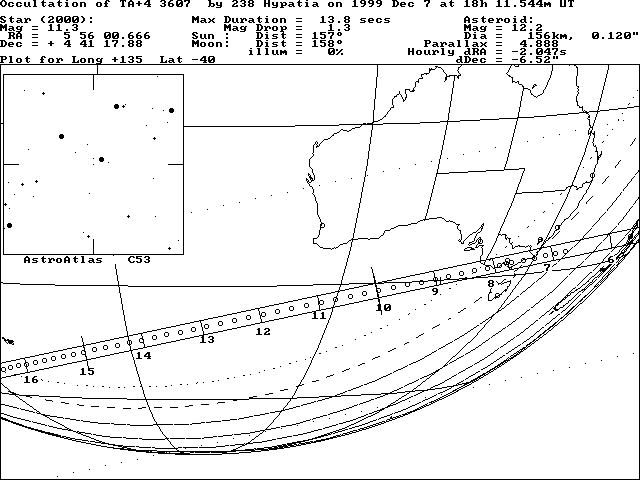ASTROMETRIC UPDATE:
OCCULTATION BY (238) HYPATIA - 1999 DECEMBER 7
THIS UPDATE REPLACES THE PREVIOUS UPDATE OF 2 DECEMBER.
CHECK THIS PAGE REGULARLY FOR FURTHER UPDATES AND CHANGES TO THE TRACK.
YOU MUST RELOAD THIS PAGE USING YOUR BROWSER'S
RELOAD/REFRESH BUTTON TO OBTAIN UPDATES!
[Prediction by Edwin Goffin]
[Prediction using OCCULT software]
Goffin's prediction suggests a path across southern Australia from around Brisbane through to Perth. The OCCULT path lies to the south with Canberra on the northern limit and Melbourne on the southern limit.
NEW UPDATE: 4 December 1999
This prediction update is supplied by Jan Manek of the Stefanik Observatory, Prague, and is based on USNO/Flagstaff astrometry for the minor planet and the TAC star position.
Summary:
This calculation gives ~0.7" south shift and time ~3 seconds later compared to Goffin's nominal path.
Path runs over very SE Australia and twilight will make the observations
hard on the Pacific coast and east part of Victoria. Melbourne lies near the centre line of the updated path. However due to uncertain star position observers within 2.5 path widths may observe an occultation. This would include Sydney, Canberra and northern Tasmania.
The TAC gives a star magnitude of 11.3 (vis) giving a predicted brighness drop is 1.3 magnitudes - enough for visual observers. But the star magnitude is also uncertain by about 0.5 magnitude. Stephen Kerr has made a ROUGH visual estimate of the stars brightness (3 December). It would appear to be around magnitude 11.6 making the brightness drop less than predicted and close to the threshold for visual observation. This combined with the absolute faintness of the star will make this observation difficult with small telescopes (< 10cm) notwithstanding the impending twilight.
THE EVENT AT ONE GLIMPSE:
- Date and approx. UT time of event: December 7, 1999 @ 18:08 UT
- Magnitude of target star: 11.3 as per TAC. Visual estimate 11.6.
- Magnitude drop [mag]: 1.3 as per TAC. Visual estimate 1.0
- Estimated maximum duration [s]: 13.8
- Path description: Far south coast of New South Wales and southern Victoria. Note that there is a significant amount of error in this predicted path.
The Occultation Path:
- Approximate width [km]: 240
- Uncertainty [path widths]: 2.5
- Uncertainty in time [s]: 30
- Map: See below
- Remarks:Uncertainties are given on basis of nominal errors of observations.
- Circles along the path are OCCULT calculated exact centerline points.
Data for the target star:
- Name: TAC +04o03607 = GSC 125 262
- Constellation: Orion
- J2000 position [h,m,s; o,',"]: 5h 56m 00.666s; +04o 41' 17.88"
- Position source: TAC 1.0
- Estimated accuracy ["]: 0.3" (0.2", 0.2")
- V mag [mag]: 11.34
- B-V [mag]: +0.7
- Remarks: Target star is a TAC star. It is the main source of path uncertainty. V mag is also uncertain. Visual estimate = 11.6.
- Target star is in north-eastern Orion, around 2.7 degrees south of Betelgeuse. Target star is 4.2' south of 9.7 mag star SAO 113274.
Data for the minor planet:
- Number, name: (238) Hypatia
- Approx. diameter [km]: 156.0 km
- Orbit source: calculation Manek
- Source of used astrometry: USNO/Flagstaff (Ron Stone), TMO (Bill Owen)
- Number of used observations:39 USNO, 5 TMO
- Number of rejected observations: 1 USNO (1998 09 18.238925)
- Time covered by the observations: 1998 07 02 - 1999 11 30
- Rms residuals ["] (RA,DE): 0.05", 0.05"
- Estimated positional accuracy at epoch of event ["]: 0.05"
- Remarks: (Note by J. Manek) The rejection of 1 USNO position is more a 'cosmetic' intervention than a must. The observations are perfect.
Data for the event:
- UT date and time of least geocentric approach: 18:11:33 UT
- Approx. V mag of minor planet at event [mag]: 12.2
- Geocentric parallax of minor planet ["]: 4.888
- Magnitude drop [mag]: 1.3 ?? (See notes above)
- Estimated maximum duration [s]: 13.8
- Apparent motion of minor planet ["/h]: 31.28
- Angular distance to moon, phase of moon [deg,%]: 158, 0%

IMPORTANT NOTE!
Astrometric updates such as these should not be taken as definitive, but rather only as an indication of where the true track may lie relative to the original predicted track. Observers must bear in mind that later astrometry, in which the target star is measured in the same field as the asteroid, may still reveal substantial changes to the predicted track and time of the event. For this reason it is most important that observers far from the predicted track still monitor the event.
Use these links for further information:
[Planetary Occultations]
[Using the Predictions]
[Observing Details]
[Timing Details]
[Reporting Details]
[Report Form]
[Asteroid Occultation Results]
This page may have been updated since 4 December 1999.
Hit your browser's RELOAD button to get the latest version.
[Site Map]
[What's an Occultation?]
[Total Occultations]
[Grazing Occultations]
[Planetary Occultations]
[Jovian Satellite Eclipses]
[Timing Occultations]
[Reporting Observations]
[Coming Events]
[Software]
[About Us]
[Publications]
[Membership]
[Links]
[Top of Page][Return to Home Page]
